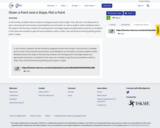
Unrestricted Use
CC BY
In this activity, students will be randomly assigned a point and a slope. They will use a movable point to plot a second point and receive visual feedback via animation as well as explicit written feedback about the slope of the line they created. All starting points and target slopes are generated randomly, so students in the class are not likely to get the same problems within a slide. They will all be practicing plotting points given a slope.
- Subject:
- Algebra I & II
- Mathematics
- Material Type:
- Activity/Lab
- Homework/Assignment
- Author:
- Javier Cabezas
- Date Added:
- 02/09/2021
